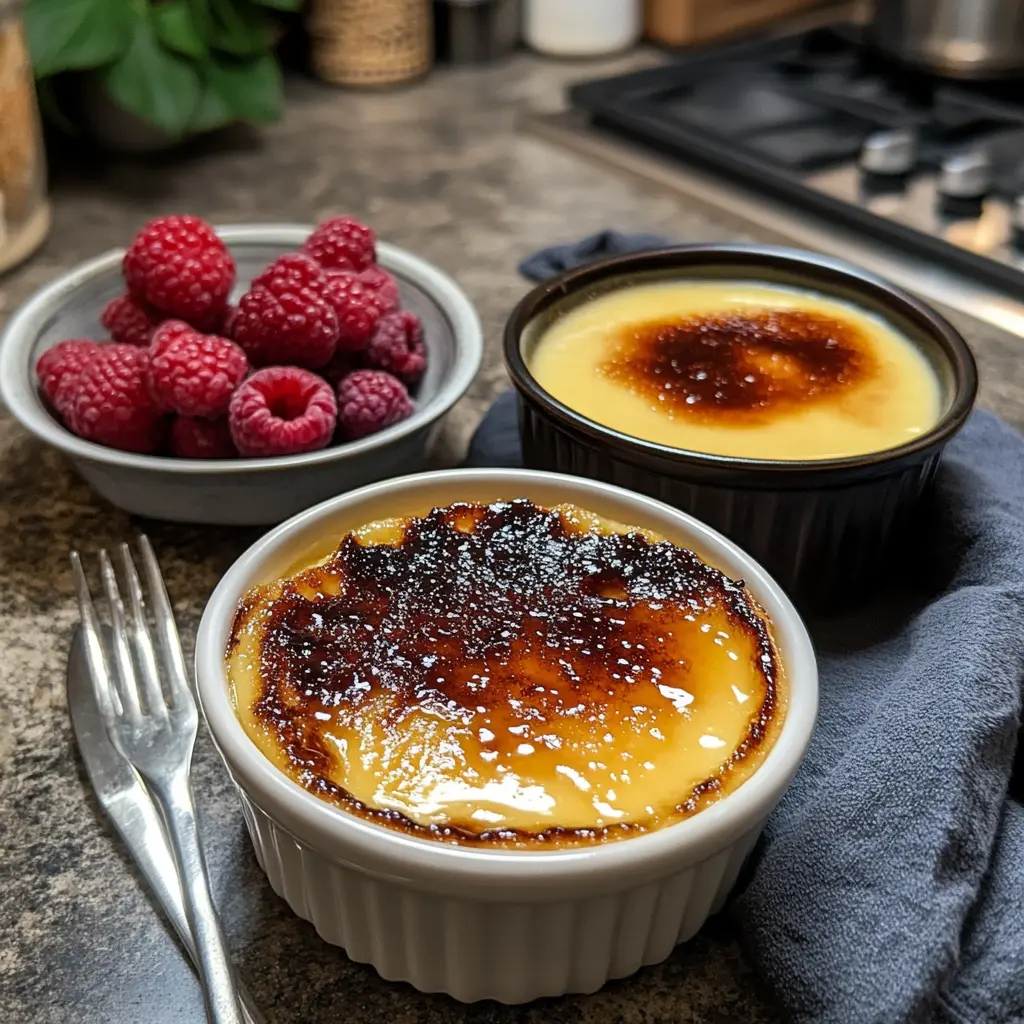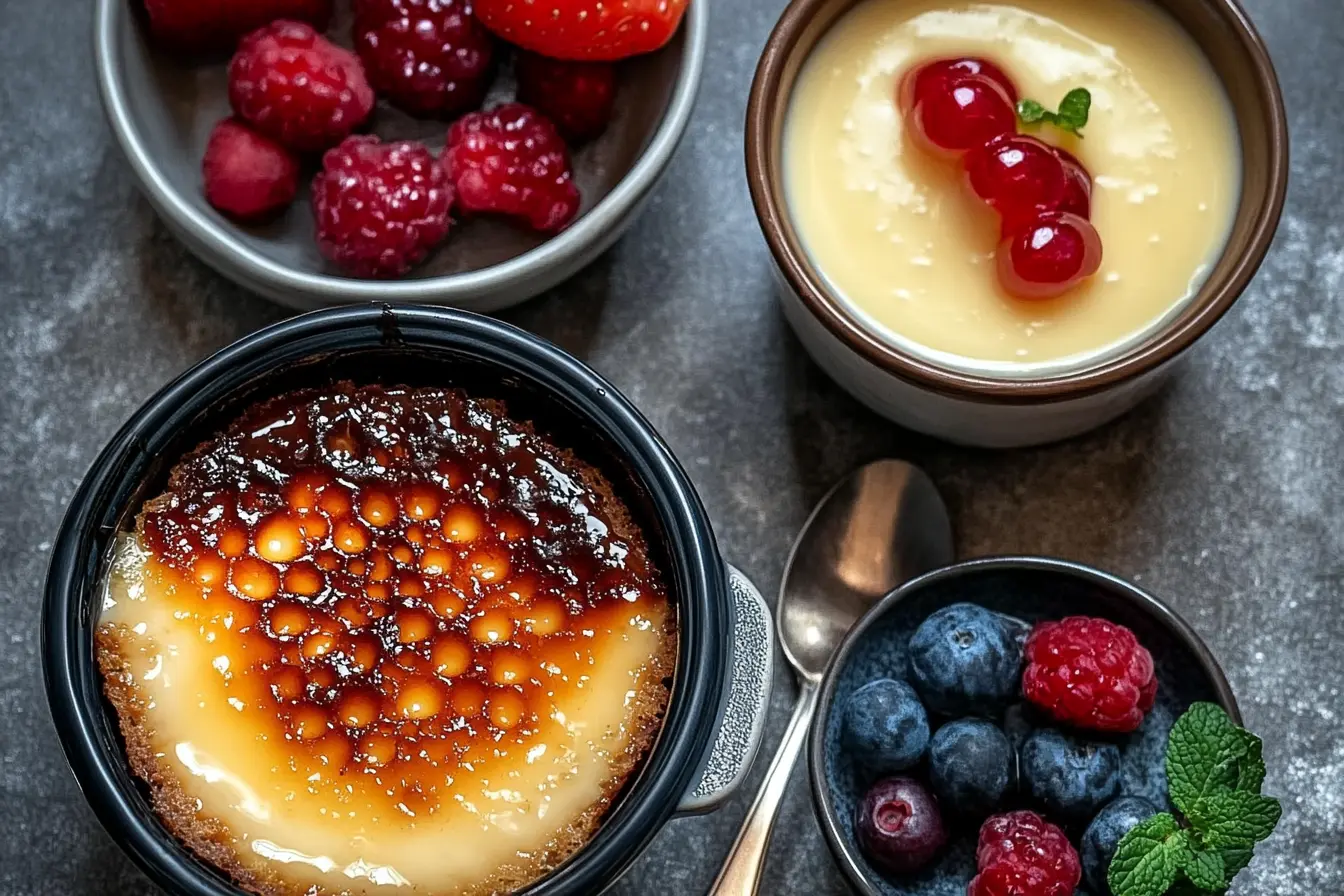If you’re a fan of creamy, luscious desserts, you’ve likely come across both crème brûlée and custard. But what’s the difference between crème brûlée and custard? When it comes to distinguishing between these two beloved treats, things can get a little tricky. Are they fundamentally the same, or do subtle differences set them apart? This article will unravel the mystery and give you all the answers.
At first glance, both desserts share similar ingredients—milk, cream, and eggs—but their preparation methods and final textures take them in entirely different directions. Whether you’re an aspiring home baker, a culinary enthusiast, or just someone with a sweet tooth, understanding the unique traits of crème brûlée and custard can enrich your appreciation for these timeless classics.
Why This Comparison Matters
Understanding what’s the difference between crème brûlée and custard is more than just a fun fact—it can help you choose the perfect dessert for any occasion. Crème brûlée is an indulgent dessert, loved for its velvety custard base and crisp caramelized sugar topping. Custard, on the other hand, is incredibly versatile, acting as both a standalone dessert and a key ingredient in pies, trifles, and sauces.
What to Expect from this Article
In this guide, we’ll explore everything you need to know about crème brûlée and custard. From their origins and preparation techniques to their nutritional profiles and cultural significance, we’ll cover it all. You’ll also learn how to make them at home, what dishes they complement, and even how to store them.
So, buckle up for a sweet journey into the world of crème brûlée and custard. Up next, we’ll dive into defining these two desserts, starting with their origins and ingredients.
Defining Crème Brûlée and Custard
To truly understand what’s the difference between crème brûlée and custard, it helps to break down each dessert’s unique qualities. Crème brûlée, which translates to “burnt cream” in French, is characterized by its creamy base and caramelized sugar crust. Custard, meanwhile, is a broad category of desserts ranging from baked custards like flan to stirred custards used as sauces or fillings.
1. Ingredients of Crème Brûlée
Crème brûlée uses a handful of basic yet luxurious ingredients:
- Heavy cream
- Egg yolks
- Sugar
- Vanilla extract or vanilla bean
The magic lies in how these components come together to create a custard that’s rich but not overly sweet. The caramelized sugar layer on top is, without a doubt, the signature finishing touch. Moreover, it adds a satisfying crunch to every bite, perfectly complementing the smooth custard underneath.
2. Method of Preparation
Preparing crème brûlée involves careful steps to achieve that flawless texture:
- Whisk together egg yolks and sugar until pale.
- Heat the cream gently with vanilla and combine it with the egg mixture, tempering to avoid scrambling.
- Pour the mixture into ramekins and bake in a water bath for even cooking.
- Once chilled, sprinkle sugar on top and torch it until golden and crisp.
Patience is key, as the dessert requires cooling to achieve the perfect set custard.
What is Custard?
Custard, a versatile dessert, is truly a culinary chameleon. In addition to being a simple base for pies, it can also shine as the star of its own show. Furthermore, it is smooth, creamy, and infinitely adaptable, making it a classic treat that is enjoyed and cherished around the world.
1. Ingredients of Custard
Traditional custard is made using:
- Milk or cream
- Egg yolks
- Sugar
- Flavorings like vanilla, nutmeg, or even fruit puree
Unlike crème brûlée, custard recipes may vary depending on whether it’s served as a standalone dessert, a filling, or a sauce.
2. Method of Preparation
Making custard is all about precision:
- Heat milk or cream gently to avoid scalding.
- Whisk together egg yolks and sugar, tempering them with the heated milk to prevent curdling.
- Stir the mixture constantly over low heat until thickened.
Custard can be baked for a firmer consistency, or alternatively, it can be cooked on the stovetop for a sauce-like texture. Moreover, it’s a foundational recipe in many desserts, such as trifles, éclairs, and even tarts, making it an essential component in the culinary world.
Now that we’ve laid the groundwork for understanding crème brûlée and custard, let’s dive deeper into their differences in the next section!
Comparing Crème Brûlée and Custard

Key Differences Between Crème Brûlée and Custard
While both desserts share similar ingredients, their unique preparation methods highlight what’s the difference between crème brûlée and custard. Crème brûlée requires a water bath and a caramelized sugar topping, giving it a rich, indulgent texture with a crunchy finish. Custard, on the other hand, can be baked or cooked on the stovetop, offering a softer texture that can be poured, set, or even layered into desserts like trifles.
1. Texture
Crème brûlée has a creamy, rich custard base with a crisp caramelized sugar crust, adding a delightful crunch. Custard, depending on its type, ranges from silky and pourable to soft and wobbly but lacks crème brûlée’s contrasting textures.
2. Flavors
Crème brûlée, on the one hand, boasts a rich vanilla flavor combined with a caramelized sweetness from its topping, thereby creating a truly decadent taste. Custard, on the other hand, is incredibly versatile, with flavors that can range from sweet, such as vanilla or fruit, to savory when used in dishes like quiche.
3. Preparation Techniques
Crème brûlée requires a water bath and caramelization of the sugar topping with a torch or broiler. Custard is more flexible, cooked either on a stovetop or baked, making it easier for beginners.
4. Culinary Uses
Crème brûlée is a standalone dessert that steals the show, while custard is often a versatile component in pastries, puddings, or sauces.
Common Misconceptions
1. Are They the Same Dessert?
Though crème brûlée is a custard, its caramelized sugar topping and specific baking method set it apart. Custard is broader, including sweet and savory variations.
2. The Role of Caramelization in Crème Brûlée
The caramelized sugar crust is crème brûlée’s hallmark, adding both texture and bittersweet flavor. Without it, it would simply be another baked custard.
Nutritional Differences
Calories in Crème Brûlée vs. Custard
When comparing crème brûlée and custard, their calorie counts reflect the richness of their ingredients. Below is a breakdown of their nutritional content (per 100g) :
| Nutritional Content (per 100g) | Crème Brûlée | Custard |
|---|---|---|
| Calories | 320 | 180 |
| Fat | 18g | 7g |
| Sugar | 28g | 16g |
| Protein | 5g | 4g |
| Carbohydrates | 30g | 20g |
This table highlights the more indulgent nature of crème brûlée compared to the lighter custard. However, variations of custard with added sugar or cream can bring their calorie counts closer together.
Nutritional Profiles of Crème Brûlée and Custard
1. Fat Content
Crème brûlée is rich in fat due to its heavy cream base, providing 15-20 grams of fat per serving. Custard, made with milk or a combination of milk and cream, contains less fat—typically 5-10 grams. Using low-fat or skim milk in custard recipes can significantly reduce the fat content, making it a lighter option.
2. Sugar Levels
Crème brûlée has a higher sugar content, with 25-30 grams per serving, largely from its caramelized sugar topping. Custard, on average, contains 15-20 grams of sugar, though sweeter versions like flan or pastry cream may approach crème brûlée levels.
3. Protein and Carbohydrates
Both desserts provide a modest amount of protein, ranging from 4-6 grams per serving, due to their egg yolk content. Custard generally contains fewer carbohydrates than crème brûlée, making it a slightly lighter choice for those mindful of carb intake.
Understanding these nutritional differences, therefore, allows you to make an informed choice and select a dessert that aligns with your preferences or dietary goals. In the meantime, let’s move on and explore how these beloved desserts are celebrated and enjoyed across the globe!
Cultural and Regional Significance
How Crème Brûlée is Celebrated Worldwide
1. French Heritage of Crème Brûlée
Crème brûlée is deeply rooted in French culinary traditions, symbolizing elegance and refinement. It first gained fame in 17th-century France, particularly in upscale dining settings. Today, it still remains a hallmark of French cuisine and is frequently served in high-end restaurants worldwide. Furthermore, the blend of creamy custard and caramelized topping has not only become synonymous with sophistication but also continues to captivate dessert lovers everywhere.
2. Modern Variations of Crème Brûlée
Although the classic recipe remains beloved, modern chefs have introduced creative twists to keep it exciting. Flavored versions, such as chocolate, lavender, and citrus, have become increasingly popular over time. Additionally, some chefs even swap out traditional ramekins for more unique presentations, such as tart shells or layered desserts, thereby showcasing its remarkable adaptability and creative potential.
The Universal Appeal of Custard
1. Custard in Different Cuisines
Custard transcends borders, appearing in countless cuisines worldwide. In Britain, it’s a key component of trifles and tarts, while in Asia, it’s used in dim sum or as a filling for steamed buns. In the U.S., custard-based pies like pumpkin or banana cream are staples of comfort food. Its versatility ensures a place on tables everywhere.
2. Variations of Custard (e.g., Flan, Pastry Cream)
Custard’s adaptability has led to many variations. Flan, a caramel-topped baked custard popular in Latin America and Spain, is a crowd favorite. Pastry cream, another derivative, is essential in éclairs, cream puffs, and fruit tarts. Each variation highlights custard’s ability to fit into both sweet and savory dishes.
Cooking Techniques for Crème Brûlée and Custard
How to Make Crème Brûlée at Home
1. Equipment Needed (e.g., Torch, Ramekins)
To make crème brûlée at home, you’ll need a few essential tools:
- Ramekins: For the custard base.
- A kitchen torch: For caramelizing the sugar topping.
- A baking dish: To create a water bath for even cooking.
These items ensure the dessert’s signature texture and finish.
2. Step-by-Step Process
- Preheat your oven to 325°F (160°C).
- Whisk egg yolks and sugar until smooth.
- Heat cream and vanilla, then slowly temper the mixture into the yolks.
- Strain the custard, pour into ramekins, and place them in a water bath.
- Bake for 30-40 minutes, chill thoroughly, and top with sugar.
- Caramelize the sugar using a torch or broiler.
3. Tips for Perfect Caramelization
For a perfectly caramelized crust:
- Use fine sugar for even melting.
- Hold the torch about 2 inches away from the surface to prevent burning.
- Rotate the ramekin as you torch to cover all areas evenly.
How to Make Custard at Home
1. Basic Custard Recipe
- Gently heat milk or cream with a pinch of sugar and vanilla.
- Whisk egg yolks with sugar until pale.
- Slowly temper the hot milk into the yolks, whisking continuously.
- Cook over low heat, stirring, until thickened.
2. Techniques to Avoid Curdling
- Use low heat and stir constantly to prevent overcooking.
- Strain the custard before cooking to remove any lumps.
- Avoid boiling the mixture, as this can cause the eggs to scramble.
3. Adjusting Consistency for Different Uses
For a thicker custard, you can either use more egg yolks or reduce the liquid. Conversely, to make it pourable, you can simply add more milk or cream. Furthermore, adjusting these ratios not only allows you to customize the custard but also ensures it works perfectly for fillings, toppings, or even as a standalone dessert.
With these techniques in mind, anyone can confidently master the art of making both crème brûlée and custard. Moreover, this knowledge allows you to bring restaurant-quality desserts into your own kitchen, impressing family and friends alike.
Serving and Pairing Ideas
Best Ways to Serve Crème Brûlée
1. Classic Serving Style
Crème brûlée is, in most cases, served in individual ramekins, thereby allowing guests to enjoy their own perfectly caramelized dessert. Furthermore, the traditional presentation not only keeps things simple but also lets the crisp sugar topping and creamy custard truly shine. Additionally, garnishing with a sprig of mint or a few fresh berries adds a delightful touch of color and freshness to the dish.
2. Creative Plating Ideas
For a modern twist, crème brûlée can be served in unique dishes like shallow tart pans or even hollowed-out fruits for a playful presentation. You can also layer it in parfait glasses with fruit compotes or whipped cream to create a visually stunning dessert. Experimenting with shapes and garnishes elevates this classic to fit special occasions.
Best Ways to Serve Custard
1. Custard as a Dessert Base
Custard, moreover, serves as a delightful base for desserts like trifles or tarts. You can layer it with sponge cake and fruits, creating a simple yet elegant treat, or alternatively, use it to fill pastry shells for éclairs or cream puffs. Additionally, its adaptability makes it a go-to option for bakers who are looking to enhance their culinary creations.
2. Incorporating Custard into Other Dishes
Custard pairs well with pies, such as pumpkin or lemon meringue, where it acts as the creamy filling. It also works wonderfully as a topping for puddings, adding depth and richness. In savory dishes, custard becomes the star ingredient in quiches or as a silky sauce for vegetables.
FAQs About Crème Brûlée and Custard
Does Crème Brûlée Taste Like Custard?
Yes, crème brûlée tastes similar to custard because they share the same base ingredients—cream, eggs, and sugar. However, crème brûlée has a richer flavor and a distinct caramelized sugar topping that sets it apart, adding a slight smoky sweetness.
What Is the Difference Between Baked Custard and Crème Brûlée?
The primary difference lies in the finishing touch. Baked custard is smooth and soft, with no topping, while crème brûlée is topped with a caramelized sugar crust that adds texture and flavor. Additionally, crème brûlée is typically richer due to the use of heavy cream instead of milk.
What Are the 3 Types of Custard?
The three main types of custard are:
- Stirred Custard (e.g., crème anglaise) – Cooked on the stovetop and often used as a sauce.
- Baked Custard (e.g., flan, crème caramel) – Set in the oven, usually in a water bath.
- Pastry Cream – A thickened custard used as a filling for desserts like éclairs and tarts.
Is Crème Brûlée Served Warm or Cold?
Crème brûlée is typically served chilled, but the caramelized sugar crust on top is warm and freshly torched. This contrast between the cool custard and the warm, crunchy topping is part of what makes the dessert so delightful.
Is Custard Traditionally Served Hot or Cold?
Custard can be served either hot or cold, depending on the dish. Baked custards, like flan, are usually chilled, while custard sauces, like crème anglaise, are often served warm. It’s incredibly versatile!
What Is the Secret to Crème Brûlée?
The secret to perfect crème brûlée lies in its caramelization. Use fine sugar for even melting, and a steady hand with the torch to avoid burning. Also, ensure the custard is fully set and chilled before caramelizing the top to achieve the ideal creamy texture beneath the crispy crust.
Wrapping Up the Difference Between Crème Brûlée and Custard
Final Thoughts on Their Unique Qualities
Crème brûlée and custard, though similar in ingredients, are two distinct desserts that cater to different preferences and occasions. Crème brûlée captivates with its silky base and caramelized sugar crust, offering a luxurious treat ideal for special moments. Custard, on the other hand, stands out for its versatility, adapting to a variety of sweet and savory dishes across global cuisines.
Exploring Both in Your Culinary Journey
Whether you’re a fan of the crunchy elegance of crème brûlée or the comforting simplicity of custard, both desserts deserve a place in your repertoire. Try making them at home to appreciate their nuances, and don’t shy away from experimenting with flavors and presentations. Exploring these timeless treats will not only expand your culinary skills but also deepen your appreciation for the art of dessert-making.
Both desserts are more than just recipes—they’re experiences, inviting you to savor their textures, flavors, and histories. So, why choose one? Delight in the best of both worlds!

